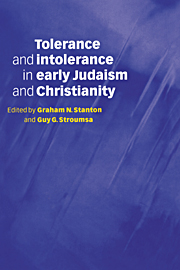Book contents
- Frontmatter
- Contents
- List of contributors
- List of abbreviations
- Introduction
- 1 Intolerance and martyrdom: from Socrates to Rabbi ‘Aqiva
- 2 The other in 1 and 2 Maccabees
- 3 The pursuit of the millennium in early Judaism
- 4 Conservative revolution? The intolerant innovations of Qumran
- 5 Who was considered an apostate in the Jewish Diaspora?
- 6 Why did Paul persecute the church?
- 7 Paul and the limits of tolerance
- 8 Philo's views on paganism
- 9 Coexisting with the enemy: Jews and pagans in the Mishnah
- 10 Tertullian on idolatry and the limits of tolerance
- 11 The threefold Christian anti-Judaism
- 12 The intertextual polemic of the Markan vineyard parable
- 13 Jews and Jewish Christians in the land of Israel at the time of the Bar Kochba war, with special reference to the Apocalypse of Peter
- 14 The Nazoreans: living at the boundary of Judaism and Christianity
- 15 Justin Martyr's Dialogue with Trypho: group boundaries, ‘proselytes’ and ‘God-fearers’
- 16 Accusations of Jewish persecution in early Christian sources, with particular reference to Justin Martyr and the Martyrdom of Polycarp
- 17 Early Christians on synagogue prayer and imprecation
- 18 Messianism, Torah and early Christian tradition
- 19 Jewish and Christian public ethics in the early Roman Empire
- Postscript: the future of intolerance
- General bibliography
- Index
2 - The other in 1 and 2 Maccabees
Published online by Cambridge University Press: 08 March 2010
- Frontmatter
- Contents
- List of contributors
- List of abbreviations
- Introduction
- 1 Intolerance and martyrdom: from Socrates to Rabbi ‘Aqiva
- 2 The other in 1 and 2 Maccabees
- 3 The pursuit of the millennium in early Judaism
- 4 Conservative revolution? The intolerant innovations of Qumran
- 5 Who was considered an apostate in the Jewish Diaspora?
- 6 Why did Paul persecute the church?
- 7 Paul and the limits of tolerance
- 8 Philo's views on paganism
- 9 Coexisting with the enemy: Jews and pagans in the Mishnah
- 10 Tertullian on idolatry and the limits of tolerance
- 11 The threefold Christian anti-Judaism
- 12 The intertextual polemic of the Markan vineyard parable
- 13 Jews and Jewish Christians in the land of Israel at the time of the Bar Kochba war, with special reference to the Apocalypse of Peter
- 14 The Nazoreans: living at the boundary of Judaism and Christianity
- 15 Justin Martyr's Dialogue with Trypho: group boundaries, ‘proselytes’ and ‘God-fearers’
- 16 Accusations of Jewish persecution in early Christian sources, with particular reference to Justin Martyr and the Martyrdom of Polycarp
- 17 Early Christians on synagogue prayer and imprecation
- 18 Messianism, Torah and early Christian tradition
- 19 Jewish and Christian public ethics in the early Roman Empire
- Postscript: the future of intolerance
- General bibliography
- Index
Summary
The first two books of Maccabees are of approximately the same length, but there are numerous differences between them. For example, the former covers the period from Mattathias to Johanan Hyrcanus (c. 167–135 BGE) while the latter begins somewhat earlier but ends its account even before Judas Maccabee dies (160 BGE); the former is Palestinian and the latter of the Hellenistic Diaspora; the former was composed in Hebrew and follows biblical models, the latter was composed in Greek and follows the model of ‘tragic’ or ‘pathetic’ Hellenistic historiography; the former features soldiers and the latter, martyrs. One point of comparison which is often ignored is their understanding of others, a point which has everything to do with their authors’ understanding of themselves.
To some extent, this difference is dictated by the specifically Hasmonean nature of 1 Maccabees: that is, 1 Maccabees is concerned, primarily, to establish the legitimacy of the Hasmonean dynasty, and this concern is reflected by its damnatio memoriae of other Jewish claimants to the high priesthood; none of them is mentioned. In contrast, 2 Maccabees not only gives us a detailed account of such condemned competitors as Jason, Menelaus and Alcimus, but also – at both the opening and the conclusion of the story (see ch. 3 and 15:12–14) – Praises at length the last Zadokite high priest, Onias III, thereby undercutting, although probably unintentionally, the Hasmoneans’ claims to being God's choice as high priests and rulers.
- Type
- Chapter
- Information
- Publisher: Cambridge University PressPrint publication year: 1998
- 2
- Cited by

